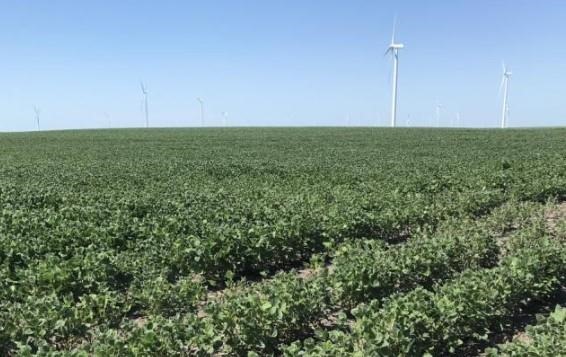By Prashant Jha
As mentioned in my previous ICM Blog article this year, June 20 was the cut-off date for over-the-top applications of dicamba products (Xtendimax, Engenia, and Tavium) in dicamba-tolerant soybean in Iowa. This was an amendment to the federal cut-off date of June 30.
Did an earlier cut-off date mitigate the problem in 2022?
Again, this year, ISU Extension field agronomists, commercial agronomists, and other stakeholders in several areas of the state have observed a high percentage of non-dicamba tolerant soybean showing injury symptoms characteristic of dicamba. This is injury consistent with what we have seen in prior years in Iowa and other states in the Midwest. Dicamba use in corn in 2022 season was widespread in addition to the dicamba used in soybean, which makes tracking down the source of injury even more challenging.

Figure 1. Injury to non-DT soybean prevalent in several regions of the state. Photo taken by field agronomist Meaghan Anderson during the week of July 11, 2022.
Speculations
Again, there have been rumors that AMS and/or glufosinate can cause cupping under stress conditions. There is no scientific evidence that AMS can cause leaf cupping in soybean. At higher rates or under stress conditions, it may cause leaf burns, but not a cupping response. Nor will Liberty applications on glufosinate-tolerant or Enlist soybeans cause cupping. Moreover, we have been using AMS with glyphosate for past several years over millions of acres of glyphosate-tolerant soybeans, but no leaf cupping has been reported.
Again this year, we heard rumors about the genetic response of Enlist soybeans to stress or Enlist (2,4-D choline) causing cupping. This is also not a valid speculation based on multiple studies conducted by university researchers. The 2,4-D symptomology on soybean is very much distinct from dicamba symptomology.
Due to the widespread presence of cupping symptomology, some have speculated that it would be impossible for dicamba to cause these symptoms on soybean without also causing similar levels of injury to tomato plants in the geography. While dicamba symptomology is not necessarily uncommon on tomatoes, it is possible to see differences in visual symptoms due to the sensitivity differences of soybean vs. tomato to dicamba. Knezevic et al. (2018) noted that rates of about 1/683 of the label rate caused 10% visual injury in tomatoes, while other researchers have seen that rates as low as 1/20,000 of the label rate caused visual injury in soybean.
Below is what appears to have occurred across much of Iowa this summer:
- The 2022 growing season has been wet, cold to begin with that delayed the planting of corn, and soybean in the majority of the state and the month of June was hot (temperatures well above 85 degrees).
- A majority of the postemergence dicamba applications occurred in the second to third week of June under those hot weather conditions, ideal for off-target movement of dicamba through volatilization. Windy conditions experienced during the application window also contributed to the particle drift in many areas of the state.
- With the delayed season and wet conditions, some fields did not receive preemergence herbicide applications. This put a burden on postemergence herbicides for controlling weeds in soybean fields and might have resulted in more dicamba being applied to dicamba-tolerant soybeans in a very small timeframe before the cut-off date of June 20.
- If dicamba application occurs during a temperature inversion, small droplets are ‘trapped’ in the air above the ground and can move across the landscape causing the symptomology to occur across miles. It’s hard to point out the source under this scenario.
- Soybean reaches susceptible stages when postemergence applications of dicamba were being made to corn due to the delayed crop development this spring. Dicamba use and rates in corn have increased in recent years due to a widespread occurrence of waterhemp populations resistant to Group 5 (atrazine), Group 9 (glyphosate) and Group 27 (HPPD inhibitors) herbicides. Nearly all of the dicamba formulations used in corn are higher in volatility than the formulations registered for use in dicamba-tolerant soybean and are often applied with ammonium sulfate and glyphosate.
Moving forward
If you have experienced a suspected herbicide incident, contact the Iowa Department of Agriculture and Land Stewardship (IDALS) at 515-281-8591 to file an “Incident Report” or a “Documentary Report” with the IDALS Pesticide Bureau. More details can be found in a previous article. You can also call at the Bayer hotline number at 1-844-RRXTEND to report off-target movement or suspected resistance issues.
With the parts of the state that received rains recently, affected soybean plants with low levels of dicamba exposure are likely to outgrow the injury. However, injury from dicamba drift is an ongoing concern and jeopardizes the use of this product as one of the few postemergence herbicide options left for controlling waterhemp in dicamba-tolerant soybean. 2,4-D choline (Enlist One) or glufosinate are also effective on waterhemp when applied over-the-top in Enlist E3 soybean.
Source : iastate.edu